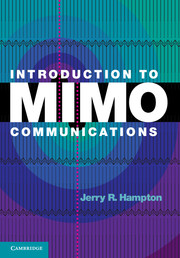Book contents
- Frontmatter
- Contents
- Preface
- 1 Overview of MIMO communications
- 2 The MIMO capacity formula
- 3 Applications of the MIMO capacity formula
- 4 RF propagation
- 5 MIMO channel models
- 6 Alamouti coding
- 7 Space-time coding
- 8 Spatial multiplexing
- 9 Broadband MIMO
- 10 Channel estimation
- 11 Practical MIMO examples
- Appendices
- References
- Index
10 - Channel estimation
Published online by Cambridge University Press: 05 December 2013
- Frontmatter
- Contents
- Preface
- 1 Overview of MIMO communications
- 2 The MIMO capacity formula
- 3 Applications of the MIMO capacity formula
- 4 RF propagation
- 5 MIMO channel models
- 6 Alamouti coding
- 7 Space-time coding
- 8 Spatial multiplexing
- 9 Broadband MIMO
- 10 Channel estimation
- 11 Practical MIMO examples
- Appendices
- References
- Index
Summary
Up to this point in the book, we have assumed that the receiver (and the transmitter in the case of eigenbeamforming) have perfect knowledge of the channel matrix. The theoretical performance results we have shown thus far have been based on that assumption. In practice, of course, the channel matrix must be estimated, and there is always some error associated with knowledge of the channel. This chapter introduces the basic concepts associated with channel estimation (CE) and presents results that illustrate how MIMO performance is affected by channel estimation errors.
Introduction
In general, there are two types of MIMO channel estimation methods: a) training-based, which uses known training symbols; and b) blind-based approaches, that perform CE without the benefit of known training symbols. In training-based CE, known training symbols are transmitted at certain prescribed times and frequencies that are known by the receiver. Since the receiver knows the training symbols, as well as when and where (i.e., at which frequencies) they are transmitted, it uses that information to estimate the gain and phase rotation imparted by the channel at each point in time and frequency based on the characteristics of the received training symbols. Although blind-based methods have higher bandwidth efficiencies because they do not use any resources for transmitting training symbols, they tend to have lower speed and poorer performance than training-based methods. For this reason, training-based CE is used more than blind-estimation, and it is the method we focus on in this chapter.
Information
- Type
- Chapter
- Information
- Introduction to MIMO Communications , pp. 214 - 231Publisher: Cambridge University PressPrint publication year: 2013
